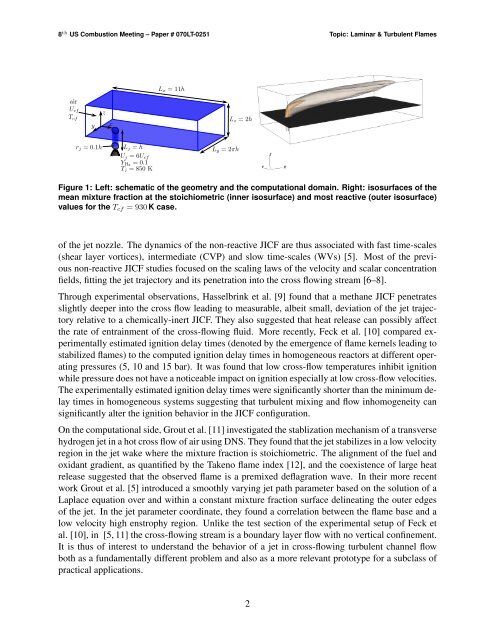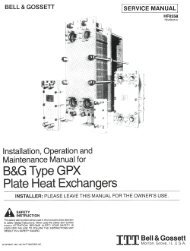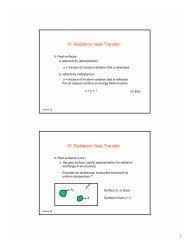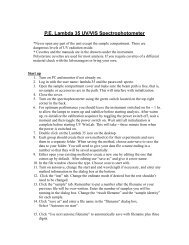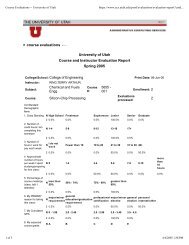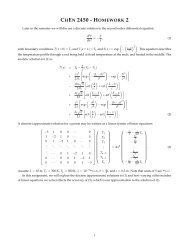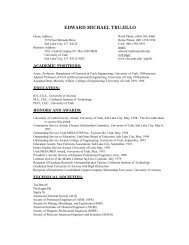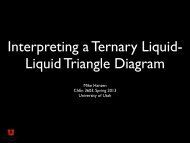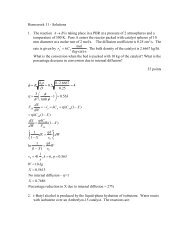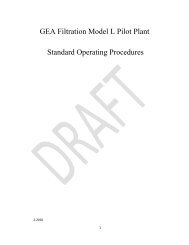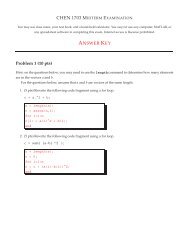Direct Numerical Simulation of Autoiginition of a Hydrogen Jet in a ...
Direct Numerical Simulation of Autoiginition of a Hydrogen Jet in a ...
Direct Numerical Simulation of Autoiginition of a Hydrogen Jet in a ...
Create successful ePaper yourself
Turn your PDF publications into a flip-book with our unique Google optimized e-Paper software.
8 th US Combustion Meet<strong>in</strong>g – Paper # 070LT-0251 Topic: Lam<strong>in</strong>ar & Turbulent FlamesFigure 1: Left: schematic <strong>of</strong> the geometry and the computational doma<strong>in</strong>. Right: isosurfaces <strong>of</strong> themean mixture fraction at the stoichiometric (<strong>in</strong>ner isosurface) and most reactive (outer isosurface)values for the T cf = 930 K case.<strong>of</strong> the jet nozzle. The dynamics <strong>of</strong> the non-reactive JICF are thus associated with fast time-scales(shear layer vortices), <strong>in</strong>termediate (CVP) and slow time-scales (WVs) [5]. Most <strong>of</strong> the previousnon-reactive JICF studies focused on the scal<strong>in</strong>g laws <strong>of</strong> the velocity and scalar concentrationfields, fitt<strong>in</strong>g the jet trajectory and its penetration <strong>in</strong>to the cross flow<strong>in</strong>g stream [6–8].Through experimental observations, Hasselbr<strong>in</strong>k et al. [9] found that a methane JICF penetratesslightly deeper <strong>in</strong>to the cross flow lead<strong>in</strong>g to measurable, albeit small, deviation <strong>of</strong> the jet trajectoryrelative to a chemically-<strong>in</strong>ert JICF. They also suggested that heat release can possibly affectthe rate <strong>of</strong> entra<strong>in</strong>ment <strong>of</strong> the cross-flow<strong>in</strong>g fluid. More recently, Feck et al. [10] compared experimentallyestimated ignition delay times (denoted by the emergence <strong>of</strong> flame kernels lead<strong>in</strong>g tostabilized flames) to the computed ignition delay times <strong>in</strong> homogeneous reactors at different operat<strong>in</strong>gpressures (5, 10 and 15 bar). It was found that low cross-flow temperatures <strong>in</strong>hibit ignitionwhile pressure does not have a noticeable impact on ignition especially at low cross-flow velocities.The experimentally estimated ignition delay times were significantly shorter than the m<strong>in</strong>imum delaytimes <strong>in</strong> homogeneous systems suggest<strong>in</strong>g that turbulent mix<strong>in</strong>g and flow <strong>in</strong>homogeneity cansignificantly alter the ignition behavior <strong>in</strong> the JICF configuration.On the computational side, Grout et al. [11] <strong>in</strong>vestigated the stablization mechanism <strong>of</strong> a transversehydrogen jet <strong>in</strong> a hot cross flow <strong>of</strong> air us<strong>in</strong>g DNS. They found that the jet stabilizes <strong>in</strong> a low velocityregion <strong>in</strong> the jet wake where the mixture fraction is stoichiometric. The alignment <strong>of</strong> the fuel andoxidant gradient, as quantified by the Takeno flame <strong>in</strong>dex [12], and the coexistence <strong>of</strong> large heatrelease suggested that the observed flame is a premixed deflagration wave. In their more recentwork Grout et al. [5] <strong>in</strong>troduced a smoothly vary<strong>in</strong>g jet path parameter based on the solution <strong>of</strong> aLaplace equation over and with<strong>in</strong> a constant mixture fraction surface del<strong>in</strong>eat<strong>in</strong>g the outer edges<strong>of</strong> the jet. In the jet parameter coord<strong>in</strong>ate, they found a correlation between the flame base and alow velocity high enstrophy region. Unlike the test section <strong>of</strong> the experimental setup <strong>of</strong> Feck etal. [10], <strong>in</strong> [5, 11] the cross-flow<strong>in</strong>g stream is a boundary layer flow with no vertical conf<strong>in</strong>ement.It is thus <strong>of</strong> <strong>in</strong>terest to understand the behavior <strong>of</strong> a jet <strong>in</strong> cross-flow<strong>in</strong>g turbulent channel flowboth as a fundamentally different problem and also as a more relevant prototype for a subclass <strong>of</strong>practical applications.2


